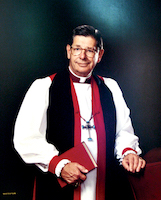Centennial Timeline
Timeline Color Key | Trinity Cathedral (Blue) | City of Phoenix, AZ (Brown)
Before 1900 | 1900-20 | 1920-40 | 1940-60 | 1960-80 | 1980-00 | 2000-20 | 2020-40 & Beyond
1960-80
1960s
Planning begins on the design of the Papago Freeway (I-10) through Phoenix and the rest of Arizona.
1960-1990
Some 3,000 houses were demolished to make way for the I-10 freeway. Nine thousand people were displaced up and down the new Interstate with Black and Latino neighborhoods disproportionately affected.
1960
Phoenix annexes Maryvale and South Phoenix. During the 1950s, Phoenix had annexed 94.86 square miles of land. Phoenix, Glendale, Tempe, and Scottsdale battle over where city boundaries should be drawn.
1960
Del Webb’s Sun City opens.
1961
Deer Valley is annexed.
1962
The Diocese elects Joseph Meaken Harte Second Bishop of the Diocese of Arizona, replacing the retiring Bishop Kinsolving. Mrs. Harte refuses to live in the Bishop’s House due to its deteriorated condition.
Photo: Bishop Joseph Meaken Hart, 1962-1979
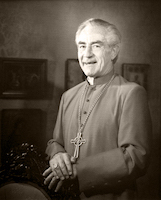
1964-1987
Elmer Bradbury Usher becomes Eighth Dean of Trinity Cathedral and serves for the next twenty-three years. Concerns begin about the condition of the Cathedral’s buildings as well as the source of funding for the Cathedral’s maintenance and operations as both business and population in downtown Phoenix seriously declines.
Photo: Dean Elmer Bradbury Usher, 1964-1987
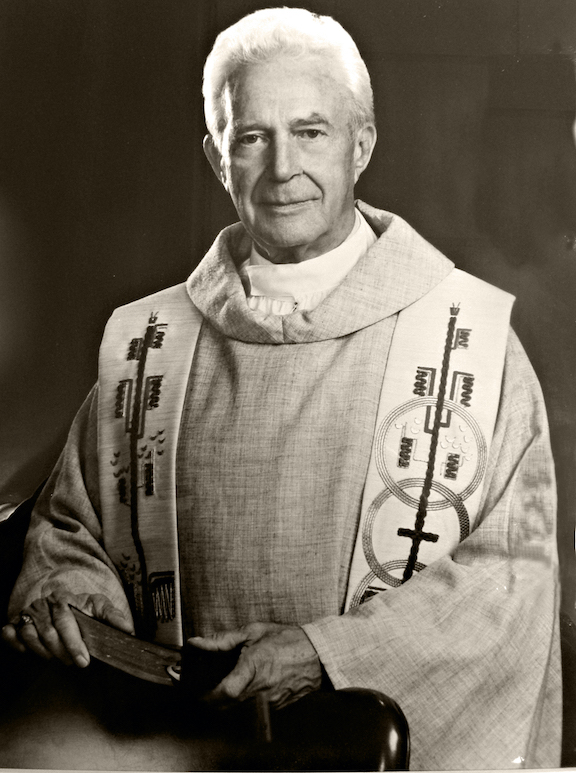
1966 November 10
Duke Ellington debuts his Concert of Sacred Music at Trinity Cathedral in two sold-out performances; the same concert was first performed in Grace Cathedral in San Francisco back in 1955. The Trinity Choir joined his orchestra, performing the choral parts under the direction of Herman McCoy, once one of the Ink Spots. The concert also features Sam Woodyard, drums; Johnny Hodges, saxophone; John Lamb, bass; Lawrence Brown, trombone; Mercer Ellington, trumpet; and Barry Briggs “danced before the Lord with all his might”.
Photo Top: Duke Ellington and Dean Usher after Ellington’s Sacred Concert, 1966.
Photo Bottom: Duke Ellington Sacred Concert poster.
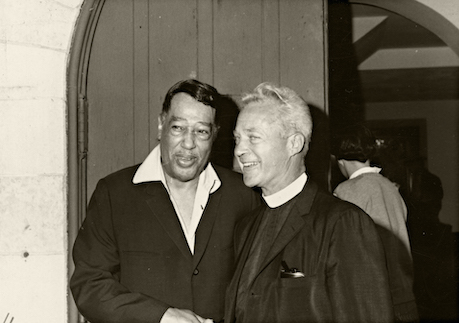
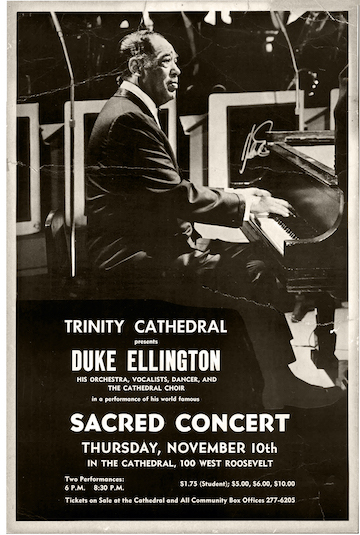
1960s
Mary (Mrs. John D.) York continues Trinity’s high-quality Christian Education programs with a cadre of dedicated volunteers despite a decline in the number of students.
Photo: Coffee hour has a long history at Trinity Cathedral. This photo represents coffee hour on the Cathedral Close, October 1963.
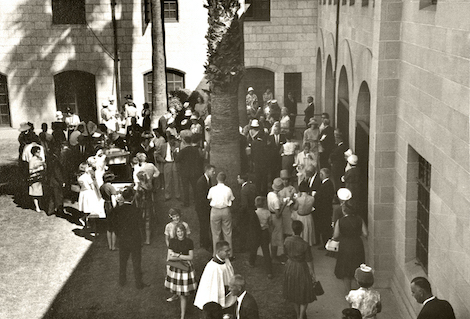
1960s-1970s
Phoenix annexes 134.55 square miles of land, now totaling 245.5 square miles.
1960-1990
In preparation for I-10 freeway, the neighborhood around Trinity Cathedral changes. Many historic houses and bungalows, including those on Latham and Moreland, are demolished. Thanks to civic leaders such as mayors Margaret Hance and Terry Goddard, the historic districts were rescued. Trinity Cathedral retains large parcels of land around it.
1965
Morrison Warren becomes first African American on the city council.
1966-1967
Dean Usher works closely with Glidden Parker, glass artist, in the design of the Cathedral nave windows. The results produced by Glassart Studio of Scottsdale are the brilliantly colored faceted stained-glass windows that have become a major part of the Cathedral’s signature in Phoenix.
Photo: Manufacturing Cathedral stained glass windows-Glassart Studios of Scottsdale 1967.
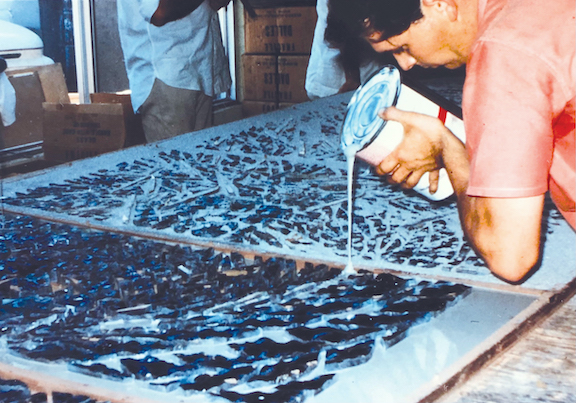
1967
Glidden Parker also designed and produced the wrought-iron entrance doors of the Cathedral. The interwoven triangles of the ironwork grill form a “Tree of Life” design similar to Spanish American and Mexican folk art. The lightly leaded and stained glass provide sound and heat barriers when closed. They are dedicated to Richard (“Fred”) Blundell, a Russian émigré, who served many years as the Cathedral’s gardener. He left all his possessions to the Cathedral. Funds from their sale paid for the great entrance doors.
Photo Top: Trinity Cathedral’s original doors.
Photo Bottom: Trinity Cathedral’s Great Entrance doors.
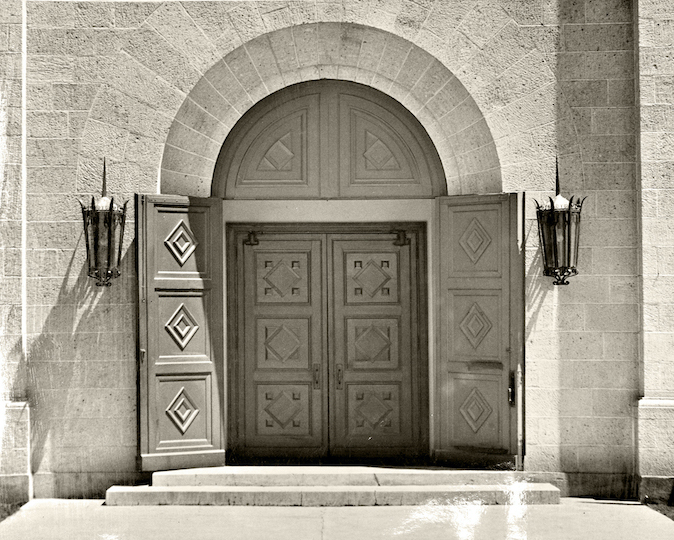
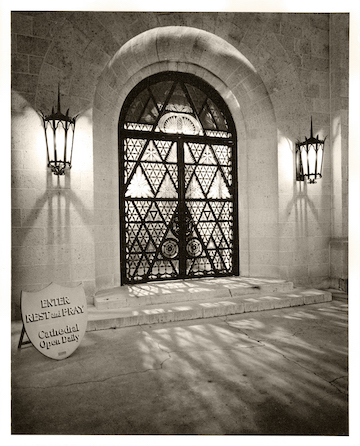
1967-1990s
Avery Olney, in memory of his wife, Gladys, funds many of the changes made in the remodeling of the Cathedral’s buildings. The sunken naves in both the Cathedral House (Olney Gallery) and Bishop Atwood House were filled and raised to the same ground level as found in the floors of the Cathedral, itself. The Chapel of the Resurrection is moved into the north end of the Cathedral Nave. New air-conditioning and heating equipment is installed in the basement beneath both the Chancel and the Olney Gallery. About half of the Bishop Atwood House kitchen is used to house that building’s air conditioning and heating equipment. A new circular stairway is built from the Olney Gallery to the second floor where the Choir’s rooms and Cathedral offices are located. In the Cathedral, a large stone altar is moved up the nave from its northern end. A curved colonnade emphasizes the new location. All pews are removed and replaced by individual church chairs. Seating capacity is reduced.
Photo: Page from fundraising brochure for the 1970 remodel.
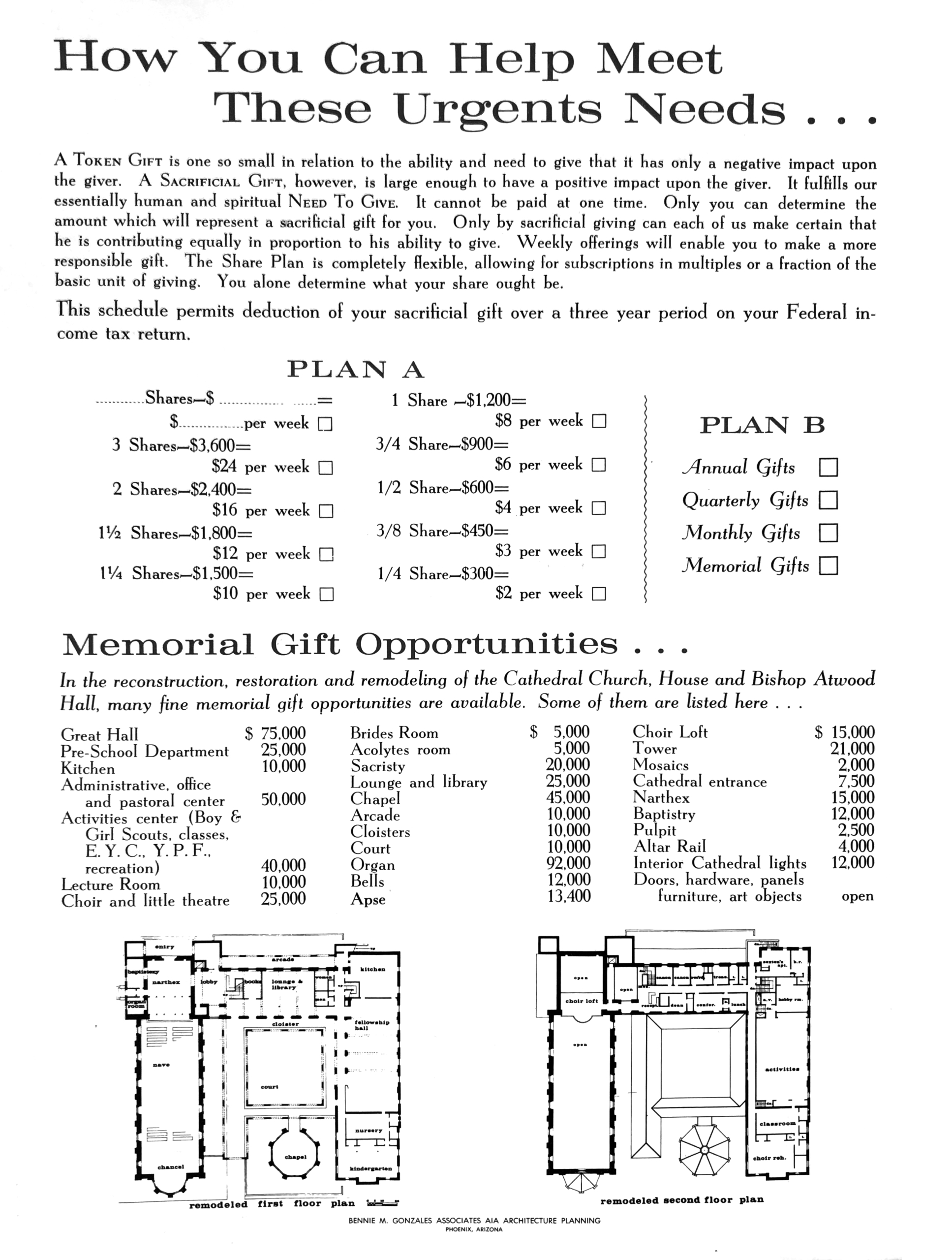
1969-1987
Dr. David Nathaniel Johnson, Professor of Organ at Arizona State University and world renown organist, becomes Trinity’s organist and choir director. In addition to his musical duties, he is also invited by Dean Usher to preach on two occasions. He also has two hymns in The Hymnal 1982: Earth and all stars (#412) and Praise the Lord! ye heavens adore him (#373).
1969
The Roman Catholic Diocese of Phoenix is established.
1969 April
Sante Fe Railway ceases passenger trains to Phoenix.
1969
The city taxes cigarettes and liquor to cover budget shortfall.
1970
Phoenix becomes the nation’s 20th most populous city.
Photo: Phoenix with Trinity near center 1970.
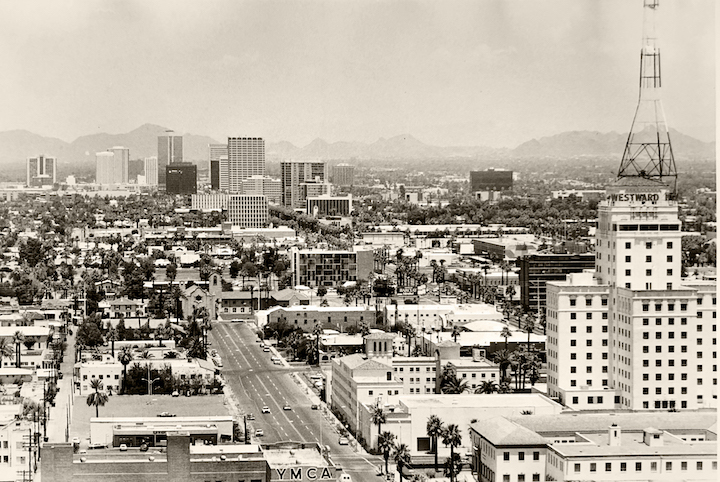
1970s-1980s
Dean Usher purchases much of the neighborhood’s vacant land for a site to construct a retirement home, but President Nixon vetoes the funds that would have built it.
1970s-1980s
Discussions ensue about a future location of Trinity to the suburbs. The Cathedral’s paved parking lot becomes a sea of mud after any rainfall. Several local apartment buildings, many owned by Trinity Cathedral, are boarded up and eventually fill with men experiencing homelessness camping within them. These circumstances render Dean Usher incapable of maintaining sufficient staffing in all areas of service at the Cathedral. Canon Ray Dugan was, at times, the only other ordained priest to assist on many Sundays until the Church could no longer pay him for his services.
Photo Top: Canon Ray Dugan.
Photo Bottom: Easter at Trinity-interior, 1977.
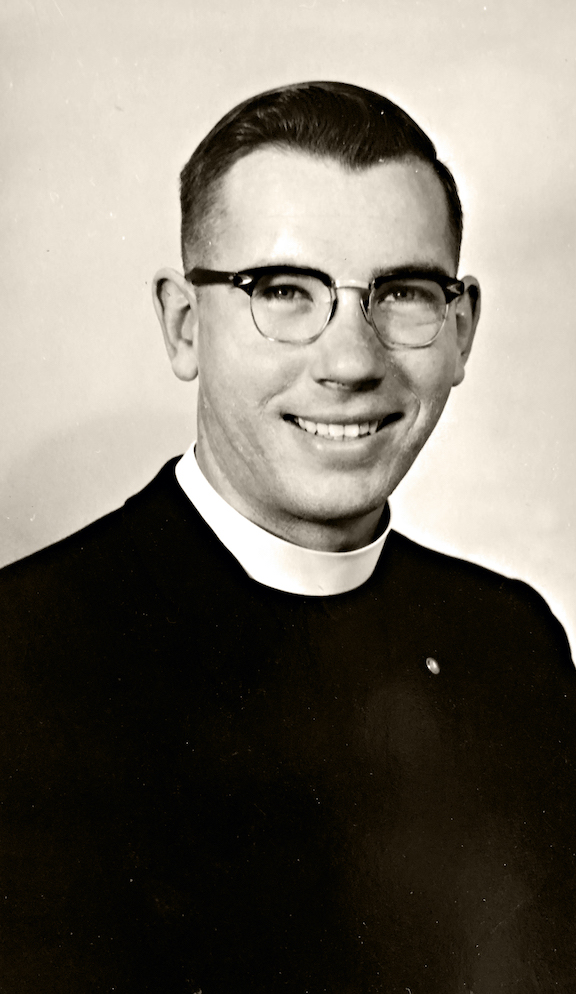
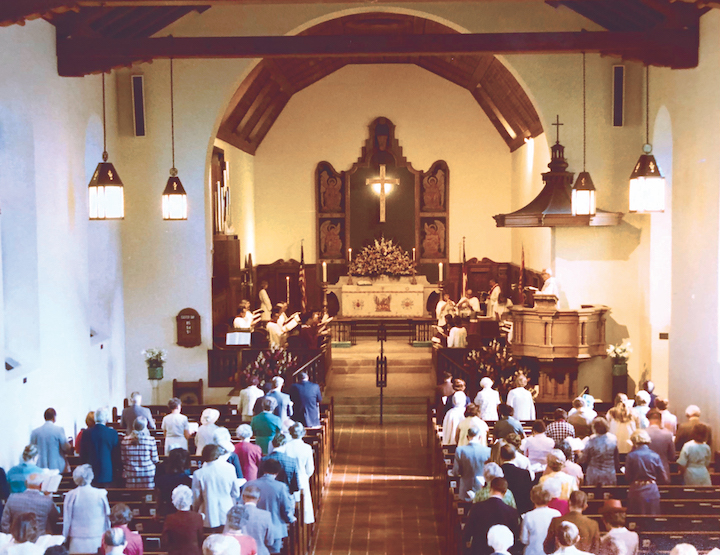
1970s-1980s
Downtown Phoenix becomes like a ghost town when its residents and retail businesses flee to the suburbs. The once prosperous Roosevelt Neighborhood deteriorates. Interstate 10 planners propose a raised thruway only a block or so north of the Cathedral. Purchase of land for the highway creates a local wasteland.
1970s
Papago Freeway (I-10) development begins.
1970
Remnants of Tropical Storm Norma slam into city, causing flooding and resulting in 23 deaths.
1970, August
Phoenix Mountains Preservation Council is founded, to purchase all the 7000 acres in the Phoenix Mountains Preserve, a total of 9700 acres.
1972
Salt River floods several times, killing 8.
1975
Phoenix elects its first female mayor: Margaret Hance, who was also a Trinity Cathedral member. She cancels a raised I-10 and causes it to be placed underground, thus creating what was originally called the Deck Park and later named Margaret T. Hance Park.
1979-1992
Rev. Joseph T. Heistand is elected Third Bishop of the Diocese of Arizona. He was previously Rector of St. Phillips in the Hills in Tucson.
Photo: Bishop Joseph T. Heistand, 1979-1992
